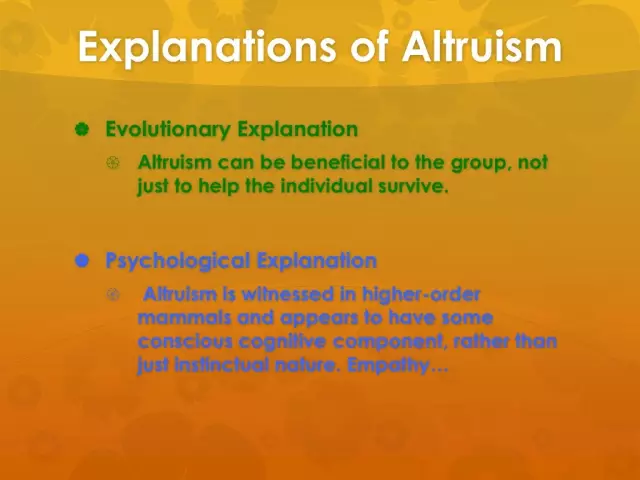- Author Rachel Wainwright [email protected].
- Public 2023-12-15 07:39.
- Last modified 2025-11-02 20:14.
Altruism

Altruism - from the Latin word "alter", which means "other" or "others." This is the principle of human moral behavior, implying disinterestedness in actions aimed at meeting the needs of the people around them, with infringement of their own interests and benefits. Sometimes in psychology, altruism is regarded either as an analogue or as a component of prosocial behavior.
For the first time the concept of altruism was formulated, as opposed to egoism, by the French philosopher, the founder of sociology Francois Xavier Comte in the first half of the 18th century. Its original definition was: "Live for the sake of others."
Altruism theories
There are three main complementary theories of altruism:
- Evolutionary. Based on the concept of "preservation of the genus - the driving force of evolution." Proponents of this theory consider altruism to be a biologically programmed quality of living things that maximizes the preservation of the genotype;
- Social sharing. Subconscious consideration in any situations of the basic values of the social economy - feelings, emotions, information, status, mutual services. Faced with a choice - to help or pass by, a person always instinctively calculates the consequences of a decision, mentally measuring the effort expended and the bonuses received. This theory interprets the provision of selfless help as a deep manifestation of selfishness;
- Social norms. According to the rules of society, which determine the behavioral responsibilities of an individual within the boundaries called norms, the provision of selfless help is a natural necessity for a person. Modern sociologists put forward this theory of altruism, as based on the principles of reciprocity - mutual support of equals, and social responsibility - assistance to people who knowingly do not have the opportunity to reciprocate (children, sick, elderly, poor). The motivation for altruism in both cases is social norms of behavior.
But none of these theories provide a complete, convincing, and unambiguous explanation of the nature of altruism. Probably because this quality of a person should also be considered on the spiritual plane. Sociology, on the other hand, is a more pragmatic science, which significantly limits it in the study of altruism as a property of human character, as well as in identifying the motives that induce people to act unselfishly.
One of the paradoxes of the modern world is that a society that has long and firmly placed price tags on everything - from material goods to scientific achievements and human feelings - continues to generate incorrigible altruists.
Types of altruism
Consider the main types of altruism, from the point of view of the above theories as applied to certain situations:
- Parental. Irrational disinterested and sacrificial attitude towards children, when parents are ready to give not only material benefits, but also their own lives for the sake of saving their child;
- Moral. Realization of their spiritual needs to achieve a state of inner comfort. For example, volunteers who are selflessly caring for the terminally ill are compassionate, content with moral satisfaction;
- Social. A type of altruism that extends to the immediate environment - acquaintances, colleagues, friends, neighbors. Free services for these people make their existence in certain groups more comfortable, which allows them to be manipulated in some way;
- Sympathetic. People tend to feel empathy, imagine themselves in the place of another person, empathizing with him. In such a situation, altruistic support to someone is potentially projected onto oneself. A distinctive feature of this type of assistance is that it is always specific and aimed at a real end result;
- Demonstrative. It is expressed in the automatic, at the subconscious level, the implementation of generally accepted norms of behavior. The assistance provided from this kind of motivation can be characterized by the expression "it should be."
Often, the manifestation of mercy, philanthropy, unselfishness, sacrifice is interpreted as altruism. But there are main distinctive features that are only inherent in the complex of altruistic behavior:
-

Altruism - selfless concern for others Gratuitousness. No personal gain from the action taken;
- Sacrifice. Expenses of personal time and own funds (material, spiritual, intellectual);
- A responsibility. Willingness to be personally responsible for the consequences of such actions;
- Priority. The interests of others are always higher than their own;
- Freedom of choice. Altruistic actions are performed solely on their own motivation;
- Satisfaction. By compromising personal interests, the altruist does not feel infringed in anything.
Altruism helps to reveal the potential of a person, because for the sake of others, a person is often able to do much more than what he does for himself. At the same time, such actions give him self-confidence.
Many psychologists believe that the propensity for altruism in people is directly related to the feeling of happiness.
It is noteworthy that zoological scientists note manifestations of altruistic behavior in their natural habitat in dolphins, monkeys and ravens.
Found a mistake in the text? Select it and press Ctrl + Enter.






